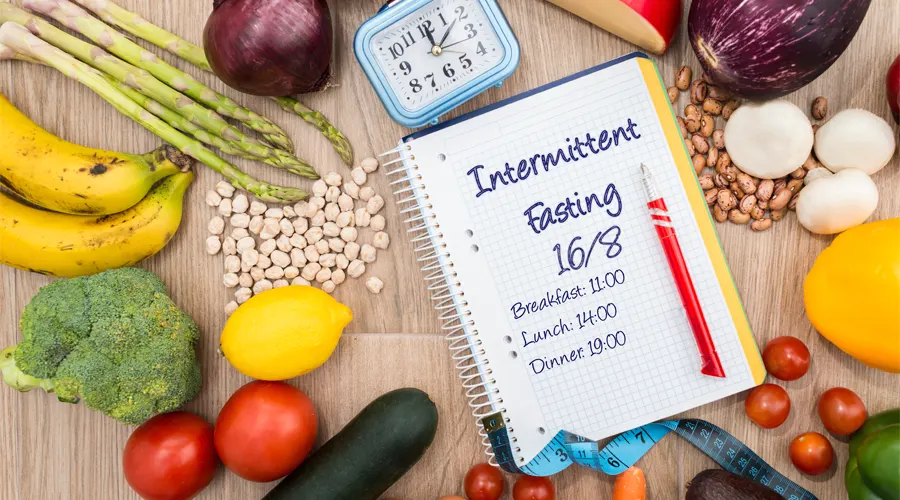Key Takeaways
- 16/8 intermittent fasting can support weight loss, improve metabolic health, and boost energy.
- With the right 16/8 fasting schedule and low-carb meals, you can achieve sustainable results.
- Starting slowly and following a meal plan will help you ease into intermittent fasting effectively.
- The 16/8 fasting method may lead to noticeable improvements in 1 month, with further benefits over time.
What is 16/8 Intermittent Fasting?
16/8 intermittent fasting involves fasting for 16 hours each day, followed by an 8-hour eating window. During the fasting period, you will only consume water, tea, and coffee, without sugar or cream in it.
The primary goal of this fasting schedule is to limit the time window in which you eat, which in turn reduces overall calorie intake and promotes fat burning. It is a simple yet effective approach to intermittent fasting that many people find sustainable in the long term.
One of the main appeals of the 16/8 fasting schedule is its simplicity. By skipping breakfast and focusing your meals within an 8-hour window (such as eating from noon to 8 pm), you can manage your calorie intake while achieving ketosis more easily.
What is ketosis? Ketosis is the fat-burning state that occurs when your body switches from using glucose as its primary fuel source to burning stored fat for energy to make it through the day[1].
Benefits of 16/8 Intermittent Fasting
There are many benefits associated with intermittent fasting, and the 16/8 fasting schedule is no exception. Some of the most notable advantages include:
- Weight loss and fat loss: The 16/7 fasting method naturally leads to a reduction in calorie intake by limiting the eating window. It also increases fat burning by promoting ketosis. If followed alongside the ketogenic diet, it can accelerate fat loss over time.
- Improved metabolic health: Intermittent fasting has been linked to improved blood sugar regulation, lower insulin levels, and better overall metabolic function[2]. By giving your body a longer break from food, the 16/8 schedule allows insulin sensitivity to improve, which can help prevent or manage type 2 diabetes.
- Enhanced mental clarity and focus: Many individuals report increased mental clarity and focus during the fasting periods. This is because fasting may increase levels of brain-derived neurotrophic factor (BDNF)[3], a protein that supports brain health and cognitive function.
- Cellular repair and longevity: During fasting, the body initiates processes of cellular repair, such as autophagy, where cells break down and remove old or damaged components. This can contribute to improved health and longevity. Research also suggests that intermittent fasting may slow the aging process and reduce the risk of age-related diseases[4].
How to Start 16/8 Intermittent Fasting
If you would like to adopt the 16/8 intermittent fasting schedule to go along with the ketogenic diet, then here are a few steps to help you get started.
Choose Your Eating Window
The first step is to choose your own 8-hour eating window. You can choose any time frame you would like. Some like to do it between 12 to 8, others 1 to 9. Maybe you can’t function without breakfast so yours is from 7 to 3. Stick with this schedule consistently to help the body adapt.
Ease Into Fasting
If you are new to intermittent fasting, consider easing into the 16-hour fast. Start with a 12-hour fasting period and gradually increase by one hour each day until you get to 16 hours.
Stay Hydrated
During fasting periods, make sure to drink plenty of water. Black coffee without sugar or cream, or herbal teas are great options. Staying hydrated keeps you healthy and makes it easier to control hunger and prevent dehydration.
Focus on Whole Foods
To maximize the benefits of intermittent fasting, focus on eating nutrient-dense, whole foods during that eating window. Prioritize lean proteins, healthy fats, and plenty of low-carb vegetables to support your body during the fasting period and help you stay full longer.
16/8 Intermittent Fasting for Beginners
If you’re new to intermittent fasting, it’s important to approach the 16/8 schedule gradually. Here’s a simple approach for beginners:
- Day 1-3: Start with a 12-hour fast. Focus on drinking black coffee, tea, or water outside of your eating hours.
- Day 4-7: Increasing fasting time to 14 hours.
- Day 8 and Beyond: Once you feel comfortable, aim for the full 16 hours of fasting with an 8-hour eating window.
During the eating window, try to stick with a low-carb intermittent fasting 16/8 plan. A diet that emphasizes whole foods like leafy greens, healthy fats, and lean proteins will not only support weight loss but also keep your energy levels steady throughout the day.
Sample 16/8 Fasting Schedule
 An image of 16/8 fasting schedule
An image of 16/8 fasting scheduleNot sure how to get started on this 16/8 fasting plan and how to stick with the ketogenic diet at the same time? Here are some examples you can follow to get this done.
Example 1:
Keep your eating window from 12 pm to 8 pm and your fasting window from 8 pm to 12 pm the next day. The meals to enjoy are:
12 pm: Grilled chicken salad with olive oil, avocado, and a side of mixed greens.
4 pm: Handful of almonds or a small keto-friendly snack.
7 pm: Baked salmon with sautéed spinach and steamed broccoli.
Example 2:
Keep your eating window between 1 pm to 9 pm and your fasting window from 9 pm to 1 pm the next day. The meals to enjoy are:
1 pm: Omelet with spinach, cheese, and a side of tomato slices.
5 pm: Low-carb protein smoothie with protein powder and almond milk.
8 pm: Zucchini noodles with marinara sauce and grilled shrimp
Read More: Intermittent Fasting Vs Keto
Is the 16/8 Intermittent Fasting Plan Right for You?
While 16/8 intermittent fasting is effective for many, it may not be suitable for everyone. If you’re someone who struggles with hunger or has certain health conditions (such as diabetes, eating disorders, or thyroid imbalances), it’s important to consult with a healthcare professional before starting this method.
Additionally, if you have a very active lifestyle, you may need to adjust your fasting schedule or eating window to support your energy needs. For some, a 16/8 intermittent fasting 7-day meal plan can help provide structure and ensure they’re eating enough to maintain energy while still reaping the benefits of fasting.
For those who have tried intermittent fasting before but didn’t see the desired results, the 16/8 fasting results 1-month benchmark can provide a good timeframe to track progress. Many people see noticeable benefits after a month of consistent fasting, including weight loss, increased energy, and improved metabolic health.
Conclusion
The 16/8 intermittent fasting schedule is an effective, easy-to-follow approach that can help improve health, promote weight loss, and boost energy levels. By fasting for 16 hours each day and eating within an 8-hour window, you give your body the time it needs to burn fat, improve insulin sensitivity, and support overall well-being.
Whether you’re a beginner or experienced with intermittent fasting, the 16/8 fasting schedule offers flexibility and simplicity. With a focus on whole, low-carb foods and a gradual approach to fasting, you can experience the long-term benefits of this method.
Over the course of 1 month or more, 4 week 16:8 fasting results can include improved body composition, increased mental clarity, and enhanced metabolic health.
If you’re wondering what to eat during intermittent fasting 16/8, focus on nutrient-dense foods and avoid processed snacks. Remember, intermittent fasting is not a one-size-fits-all approach, so listen to your body and adjust the fasting schedule as needed for optimal results.



